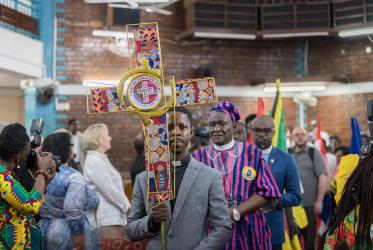In Kenya, the drought has emptied pantries – making a packet of maize meal or rice or even a bottle of cooking oil very precious. Here, the food shortages are severe, as the drought triggers serious water scarcity and snuffs-out pasture for livestock.
“The situation is very bad. The people are seriously in need of food and water. With no pasture, the cows are eating anything they can find. Many of them are dying,” Anglican Bishop David Mutisya of Garissa said. “We are preparing to distribute food to the people. We are complimenting the government’s efforts.”
As he serves in the homeland of nomadic, pastoralist Maasai—one of the affected regions—Kenya Evangelical Lutheran Church Bishop, Johnes Ole Meliyio regretted that the current efforts against the drought were insufficient.
“The need is very huge and it’s escalating,” he said. “The livestock are dying and the farmers cannot sell them because the animals are too weak. For those who sell, the money is too little to buy enough hay to save the remaining ones.”
The cleric calls for a quick solution to help the people survive the drought.
In the country, at least 4 million people are in need of humanitarian aid due to the drought.
“We urgently ask that your government …to…declare famine and drought a national disaster to facilitate the concentration of efforts and resources to safeguard the lives of Kenyans and livestock from imminent death and malnutrition,” said Rev. Chris Kinyanjui, general secretary of the National Council of Churches of Kenya.
Climate scientists and environmental experts explain that the persistent droughts in Kenya, Somalia, and Ethiopia are a result of climate change. They also warn that the droughts will continue into the future. Clerics say it’s a matter of life and death and the communities should be aided to cope. Observers say the war in Ukraine and the recent COVID-19 pandemic have exacerbated the crisis.
In the Machakos, Kitui, Makueni, and Garissa Anglican dioceses in Kenya, the four bishops have been working together—through Anglican Development Services-Eastern—to tackle challenges related to the persistent droughts in their regions.
According to the bishop, access to water for farming and good seeds holds the key to solving the food shortages linked to the droughts in the region. He said the soils in his region are fertile enough to sustain food production, but that would only be realised if the people had access to water for irrigation—either in dams or through boreholes.
“The people have the knowledge. Knowledge is power and we are educating them on how to live better by changing their lifestyles,” said Mutisya.
The bishops have been telling the nomadic pastoralists to adopt crop farming while keeping a limited number of animals, or start businesses. They are also telling farming communities to adopt drought-resistant food crops such as millet and sorghum. The church has also been helping the communities start saving schemes.
“We believe these actions will provide some relief for our communities,” he says.
In the long term, Ole Meliyio like his fellow Garissa bishop. urges the prioritization of water harvesting methods for agriculture and consumption.
“If there are dams built, the communities can grow their own food and pasture for their animals,” he said “I think, after the drought, the communities will need small loans to re-start life. All their livelihoods have been destroyed by drought.”








